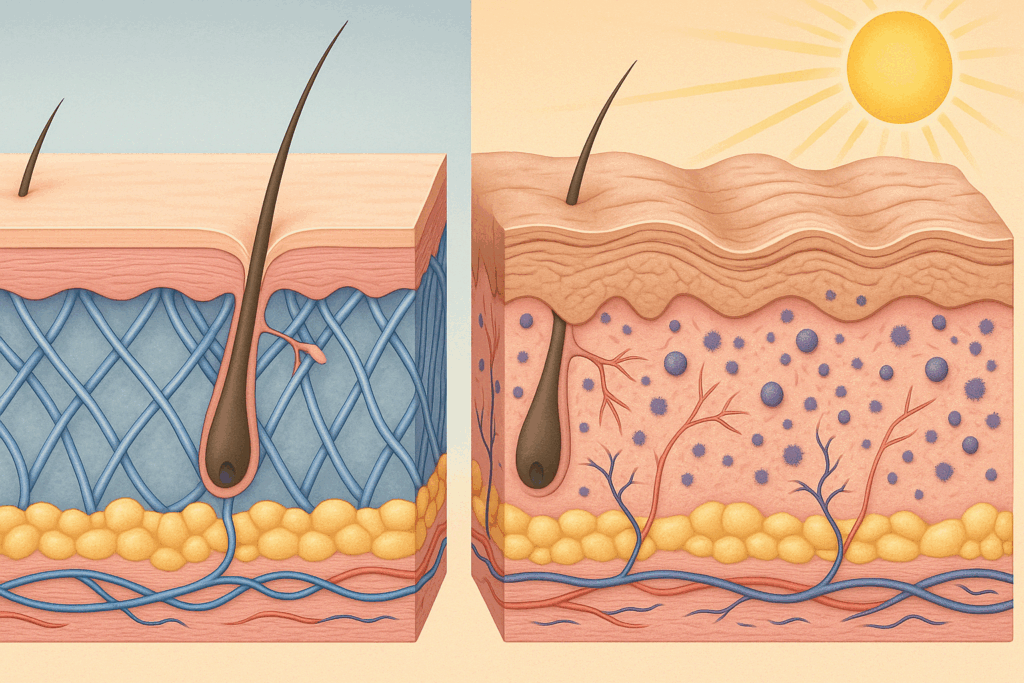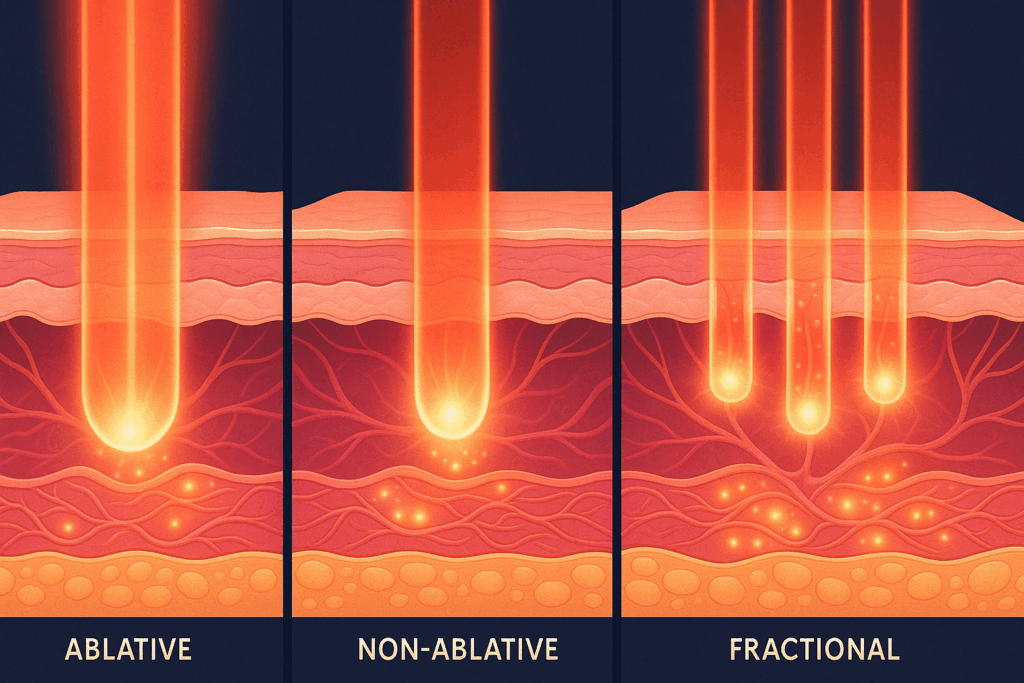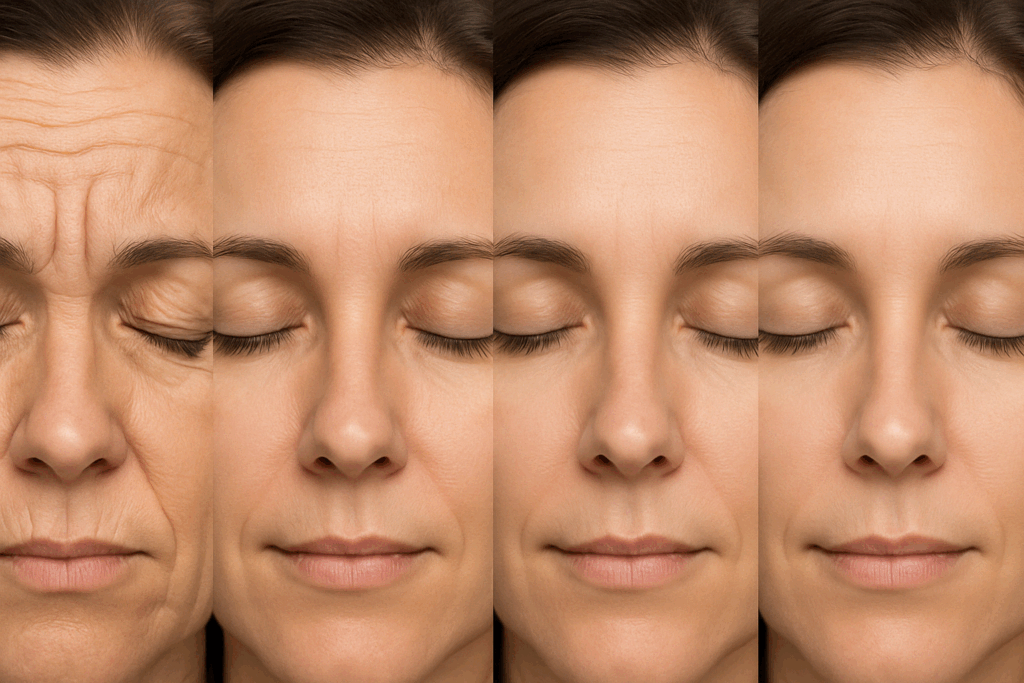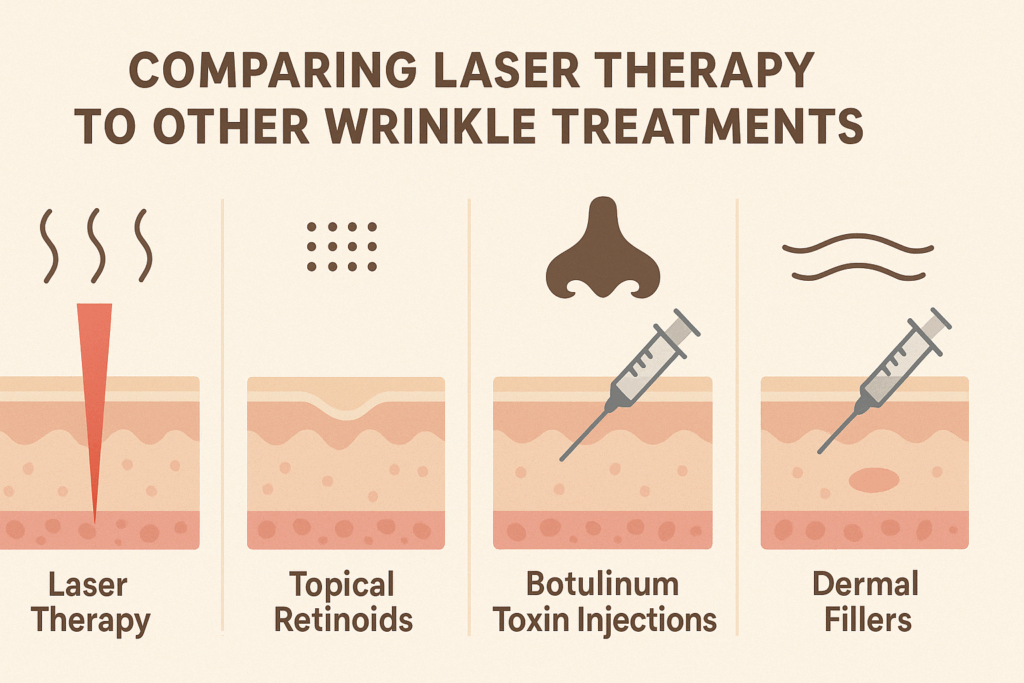In the ever-evolving world of aesthetic dermatology, few concerns prompt as many consultations as the appearance of forehead wrinkles. These visible signs of aging often become a primary focus for individuals seeking to preserve a youthful appearance without resorting to invasive surgery. With technological advancements, laser treatment for forehead wrinkles has emerged as one of the most effective, non-surgical methods for rejuvenating the skin. Guided by expert insights and supported by evidence-based dermatology, this article explores how laser treatments can transform the skin’s texture, reduce fine lines, and restore confidence—while maintaining a firm foundation in scientific credibility and medical ethics.
You may also like: How to Choose Skin Care for Fine Lines: Evidence-Based Tips for Healthier, Younger-Looking Skin

Understanding the Formation of Forehead Wrinkles
Forehead wrinkles develop through a combination of intrinsic aging processes and extrinsic environmental factors. Intrinsically, the body undergoes natural biological changes over time. Collagen and elastin, two essential proteins responsible for skin structure and elasticity, decline gradually beginning in one’s late twenties. Simultaneously, skin cell turnover slows, hydration diminishes, and the dermis becomes thinner. These changes create the perfect environment for wrinkles to appear and deepen over time, particularly in expressive areas like the forehead.
Extrinsic aging, driven by environmental and lifestyle choices, can dramatically accelerate this process. Sun exposure, smoking, air pollution, chronic stress, and poor nutrition all contribute to oxidative stress and inflammation in the skin. The forehead, being one of the most sun-exposed areas of the face, is particularly vulnerable. Frequent frowning, squinting, or raising the eyebrows activates the frontalis muscle, contributing to dynamic wrinkles. Over time, these dynamic lines become static, etched into the skin even when the face is at rest.

The Science Behind Laser Skin Resurfacing
Laser treatment for forehead wrinkles works by harnessing focused light energy to remove damaged outer layers of skin and stimulate collagen production in the deeper layers. Depending on the type of laser, this process can be ablative, non-ablative, or fractional. Ablative lasers, such as CO2 or Erbium lasers, vaporize the outer layers of skin to reveal new, smoother skin beneath. Non-ablative lasers, like Nd:YAG and diode lasers, work deeper in the skin without damaging the surface, promoting collagen growth over time. Fractional lasers combine both approaches, treating microscopic columns of skin while leaving surrounding tissue intact, which promotes faster healing.
By targeting water and pigment within the skin, these lasers deliver controlled thermal damage that kickstarts the body’s natural wound-healing response. This process leads to dermal remodeling, including the proliferation of fibroblasts and the reorganization of collagen fibers. The result is a significant improvement in skin texture, firmness, and tone. Dermatologists often customize laser treatments based on the patient’s skin type, wrinkle severity, and overall aesthetic goals, ensuring a tailored and effective approach.

How Laser Treatment for Forehead Wrinkles Improves Skin Appearance
Patients undergoing laser treatment for forehead wrinkles typically notice a series of progressive improvements. In the weeks following treatment, the skin begins to exfoliate, revealing a brighter and more even complexion. As collagen production accelerates over several months, forehead lines begin to soften, and skin elasticity improves. These results are not merely superficial; they reflect real physiological changes occurring in the skin’s architecture.
For individuals concerned about moderate to deep forehead wrinkles, fractional ablative lasers have demonstrated particularly impressive outcomes. These treatments often require minimal downtime and can be performed in an outpatient setting. Importantly, dermatologists emphasize that results are cumulative. A series of sessions spaced weeks apart is generally more effective than a single treatment. Moreover, consistent aftercare and sun protection are critical to maintaining long-term benefits and preventing recurrence.

The Psychological Impact of Smoother Forehead Skin
Beyond the visible changes, laser forehead wrinkle treatments can profoundly influence mental and emotional well-being. Research in psychodermatology underscores the strong link between skin appearance and psychological health. When individuals feel more confident in their appearance, they often report improvements in mood, self-esteem, and social engagement. This is especially relevant for individuals who have struggled with premature aging or skin damage due to lifestyle or environmental exposures.
Forehead wrinkles can carry social and psychological connotations, often being misinterpreted as signs of fatigue, worry, or irritability. Patients frequently express that their external appearance does not match their internal vitality. By smoothing these lines, laser treatments help harmonize the outer expression with the inner self, promoting a more authentic and empowered identity. Dermatologists often observe that patients who undergo these procedures return not only with better skin but with a brighter outlook on life.

Expert Dermatologist Recommendations on Choosing the Right Laser Treatment
Selecting the right laser for forehead wrinkles is a nuanced decision that requires professional expertise. Dermatologists consider multiple variables, including skin tone, wrinkle depth, sensitivity, and any history of scarring or pigmentation disorders. For lighter skin types, ablative lasers can be very effective with a relatively low risk of hyperpigmentation. However, for darker skin tones, non-ablative or fractional lasers are often preferred to reduce the risk of post-inflammatory pigmentation.
Board-certified dermatologists also assess whether the patient is a good candidate for laser treatment by evaluating underlying medical conditions, medications, and lifestyle factors that may affect healing. They emphasize realistic expectations, noting that while laser treatment for forehead wrinkles can yield dramatic improvements, it may not completely eliminate every line. In some cases, combining laser therapy with other modalities, such as botulinum toxin injections or hyaluronic acid fillers, can produce more comprehensive results.
What to Expect During and After the Procedure
Understanding what to expect during the laser treatment process can help reduce anxiety and improve patient outcomes. Most laser treatments for forehead wrinkles are performed in-office and last between 30 minutes to an hour, depending on the extent of the area being treated. A topical anesthetic is typically applied to reduce discomfort. Some patients describe the sensation as a mild stinging or snapping feeling, similar to the snap of a rubber band against the skin.
Post-procedure recovery varies by laser type. Ablative treatments may require up to two weeks of downtime, during which the skin may appear red, swollen, or scabbed. Non-ablative treatments, on the other hand, involve little to no downtime, though patients may experience temporary redness and mild swelling. Dermatologists provide detailed aftercare instructions to minimize the risk of infection and promote optimal healing. Sun avoidance and the use of broad-spectrum sunscreen are especially crucial, as the skin is more vulnerable to UV damage following laser procedures.

Comparing Laser Therapy to Other Wrinkle Treatments
While laser therapy is a powerful tool in the anti-aging arsenal, it is important to compare its efficacy with other common treatments for forehead wrinkles. Topical retinoids, such as tretinoin, are widely used for long-term collagen stimulation and prevention of fine lines. However, their effects are gradual and often less noticeable than those achieved with laser resurfacing. Similarly, over-the-counter products containing peptides, antioxidants, and hyaluronic acid may improve hydration and texture but cannot match the depth of change induced by laser energy.
Injectables such as botulinum toxin (e.g., Botox) are frequently used to reduce dynamic wrinkles by relaxing the underlying muscles. These treatments are highly effective for motion-related forehead lines but do not address skin texture or sun damage. Dermal fillers can be used to plump deep lines but may not be suitable for the upper forehead, where excessive volume can appear unnatural. In contrast, laser treatment for forehead wrinkles addresses both the surface and subsurface components of aging, making it a comprehensive solution for many patients.
Tailoring Treatment Plans for Individual Needs
A key advantage of laser therapy lies in its adaptability. Dermatologists can calibrate laser settings based on the patient’s needs, gradually increasing intensity over time for those with sensitive skin or layering treatments for enhanced effects. This personalized approach ensures that the therapy aligns with the individual’s aesthetic goals, healing capacity, and lifestyle.
In addition, the choice of accompanying skincare products plays a significant role in the treatment plan. Formulations rich in niacinamide, ceramides, and peptides can support the skin’s recovery and enhance barrier function post-treatment. Dermatologists may also recommend antioxidants such as vitamin C serums to protect against free radicals and boost collagen synthesis. The integration of at-home skincare with professional laser sessions creates a synergistic effect, amplifying results and extending their longevity.
Addressing Common Myths and Concerns About Laser Treatments
Despite its growing popularity, laser treatment for forehead wrinkles is often misunderstood. One common myth is that laser treatments are painful and unsafe. In reality, modern laser technologies have evolved significantly to offer safer, more comfortable experiences with built-in cooling mechanisms and precision targeting. Another misconception is that results are immediate. While some improvement is noticeable within days, the most dramatic results typically emerge over the course of several weeks to months as collagen remodeling progresses.
Concerns about cost and accessibility also surface frequently. While it is true that laser treatments represent a financial investment, many patients find the long-lasting results well worth the expense, particularly when compared to the ongoing costs of less effective over-the-counter products. Moreover, clinics often provide flexible payment options or package deals to make treatments more accessible. Dermatologists encourage potential patients to seek consultations with reputable providers to understand the true scope of benefits and risks.
Safety and Risks: What Patients Should Know
Like all medical procedures, laser treatments come with potential risks, which are significantly minimized when performed by experienced professionals. Common side effects include temporary redness, swelling, and peeling. In rare cases, patients may experience scarring, infection, or pigmentary changes. Proper patient selection, adherence to post-procedure care, and the use of FDA-approved devices are essential safeguards that enhance safety and effectiveness.
Pre-treatment consultations are indispensable for mitigating risks. During this time, dermatologists review the patient’s medical history, current medications, and skin sensitivities. They may conduct a patch test to assess how the skin will respond to the laser. Transparent communication about goals, timelines, and potential side effects fosters trust and promotes a collaborative therapeutic relationship. When performed under optimal conditions, laser treatment for forehead wrinkles has a well-established safety profile supported by years of clinical data.
Long-Term Skin Health and Maintenance
While laser therapy can deliver transformative results, its longevity depends heavily on post-treatment skin care and lifestyle. Patients who adopt a proactive approach to skin health, including daily sunscreen use, hydration, and a balanced diet rich in antioxidants, tend to enjoy longer-lasting improvements. Smoking cessation, stress management, and regular sleep patterns also contribute to healthier skin and enhanced treatment outcomes.
Dermatologists often recommend annual or biannual maintenance sessions to preserve collagen levels and prevent the reappearance of fine lines. These follow-up treatments are generally less intensive than the initial session and can be adjusted based on seasonal changes or evolving skin needs. By integrating laser therapy into a comprehensive skin health regimen, patients can sustain smoother, more youthful skin well into later adulthood.
Why Dermatologists Trust Laser Therapy for Forehead Wrinkles
Laser treatments have earned the trust of dermatologists worldwide due to their scientific efficacy, customizable nature, and ability to deliver visible, measurable results. Unlike superficial treatments that offer temporary benefits, laser therapy initiates a biological response that supports structural skin repair. This approach aligns with modern dermatology’s commitment to evidence-based care and patient-centered outcomes.
As with all aesthetic procedures, patient education is critical. Reputable dermatologists prioritize informed consent, realistic goal-setting, and post-treatment guidance. They help patients navigate the evolving landscape of cosmetic treatments while upholding the highest standards of safety and professionalism. The combination of technological precision and medical oversight makes laser treatment for forehead wrinkles not only effective but also a trustworthy option for individuals seeking lasting skin rejuvenation.
Frequently Asked Questions: Laser Treatment for Forehead Wrinkles
1. Can laser treatment for forehead wrinkles be combined with other skin rejuvenation methods?
Absolutely. Dermatologists often recommend a multimodal approach to maximize results, especially when addressing more advanced signs of aging. For example, pairing laser treatment for forehead wrinkles with neuromodulators like Botox can reduce dynamic wrinkles while the laser targets texture and tone. Additionally, microneedling and platelet-rich plasma (PRP) therapies can be used alongside laser treatments to further stimulate collagen and enhance recovery. This combined strategy allows for more holistic results and is particularly effective when guided by a personalized dermatological evaluation.
2. How does lifestyle impact the effectiveness of laser forehead wrinkle treatments over time?
Lifestyle plays a crucial role in both the immediate healing process and long-term outcomes of laser forehead wrinkle treatments. Factors like UV exposure, smoking, stress levels, and sleep quality can all influence how well your skin responds to the procedure. For instance, chronic sun damage may counteract the benefits of the laser by degrading collagen. Patients who maintain a consistent skincare routine, including antioxidants and sunscreen, tend to experience longer-lasting results. This means that even the most advanced laser treatment for forehead wrinkles requires an ongoing commitment to healthy habits.
3. Are there differences in outcomes based on skin tone or ethnicity?
Yes, skin tone and ethnic background are important considerations when selecting the appropriate laser technology for forehead wrinkle reduction. Individuals with darker skin tones are at higher risk of post-inflammatory hyperpigmentation if treated with aggressive ablative lasers. For this reason, non-ablative and fractional lasers are often preferred for skin of color, as they carry a lower risk profile while still being effective. Board-certified dermatologists with experience in treating diverse skin types can adjust laser parameters to optimize safety and efficacy. Personalized care is essential in ensuring that laser forehead wrinkle treatments provide equitable outcomes across all ethnic backgrounds.
4. What are some emerging trends in laser technology for forehead wrinkle reduction?
The field of aesthetic dermatology is rapidly evolving, with newer devices offering enhanced precision and reduced recovery time. Innovations such as picosecond and hybrid fractional lasers are becoming increasingly popular due to their ability to target both superficial and deep layers simultaneously. These devices combine different wavelengths to treat pigment, wrinkles, and laxity in a single session. Additionally, AI-assisted platforms are beginning to emerge, offering real-time feedback and personalized treatment parameters based on skin response. These technologies are revolutionizing how laser treatment for forehead wrinkles is performed, making it more efficient and customizable than ever before.
5. How do seasonal changes affect the timing of laser forehead wrinkle procedures?
Timing a laser procedure around seasonal shifts can significantly impact both healing and results. Cooler months are often preferred for laser forehead wrinkle treatments because the reduced sun exposure lowers the risk of hyperpigmentation and improves post-treatment skin protection. Summer procedures, while possible, require meticulous sun avoidance and high-SPF sunscreens, which may not be feasible for all patients. Some dermatologists recommend scheduling treatments during fall or winter to align with optimal recovery conditions. This seasonal consideration ensures the skin heals under the most favorable circumstances, enhancing the overall effectiveness of the treatment.
6. What psychological changes do patients commonly report after laser wrinkle reduction?
Patients frequently experience significant psychological benefits following laser treatment for forehead wrinkles. Many report a noticeable boost in confidence, particularly in social and professional settings where appearance may impact self-perception. This confidence often stems from the internal alignment between how patients feel and how they believe they are perceived. Some also express a sense of emotional relief, especially if forehead wrinkles had been contributing to unwanted assumptions about their mood or age. These emotional shifts underscore how deeply interwoven aesthetic concerns can be with mental and emotional health.
7. Is there an ideal age to begin laser treatment for forehead wrinkles?
There is no universal age at which one should begin laser treatment, but many dermatologists now advocate for preventive intervention in the late twenties to early thirties. At this stage, collagen production begins to decline, but skin still retains much of its resilience, allowing laser procedures to serve as proactive rather than reactive measures. Early treatment may slow the progression of deeper wrinkles and reduce the need for more aggressive interventions later in life. However, older adults can still benefit greatly, particularly when laser treatment for forehead wrinkles is tailored to their unique skin aging patterns. Age matters less than skin condition and individual treatment goals.
8. How do hormonal changes affect results from laser forehead wrinkle treatments?
Hormonal fluctuations—such as those occurring during menopause, pregnancy, or thyroid imbalance—can influence how the skin heals and responds to laser therapy. Estrogen, for instance, plays a role in collagen synthesis and hydration, meaning that its decline may result in less robust skin regeneration. Patients undergoing hormone replacement therapy (HRT) may find they heal faster or retain results longer compared to those with untreated hormonal deficiencies. Discussing hormonal health with your provider ensures that your laser forehead wrinkle treatment plan is grounded in a broader understanding of your systemic health. A multidisciplinary approach can enhance treatment results and minimize setbacks.
9. What are some lesser-known post-treatment strategies for maintaining smooth skin?
Beyond sunscreen and gentle moisturizers, certain underutilized strategies can significantly prolong the benefits of laser treatment for forehead wrinkles. Incorporating a humidifier into your environment can help maintain skin hydration during healing, especially in dry climates or during winter. Regular lymphatic drainage massage promotes circulation and reduces post-procedural swelling more efficiently. In addition, topical growth factors and peptides, available in medical-grade skincare lines, may support collagen remodeling in the weeks following treatment. These thoughtful enhancements can subtly optimize healing and maximize the smoothness achieved through laser therapy.
10. Can laser treatments have an impact on other concerns beyond forehead wrinkles?
Yes, one of the most compelling advantages of laser forehead wrinkle treatments is their ability to simultaneously address multiple skin concerns. While the primary goal may be wrinkle reduction, many patients also notice improvements in overall tone, texture, and pigmentation. This means issues like sun spots, rough patches, and enlarged pores often diminish in the same treatment cycle. Moreover, some laser systems are specifically designed to treat early precancerous lesions, offering both cosmetic and medical benefits. Thus, laser therapy can be a strategic investment not only in aesthetics but in long-term skin health and disease prevention.
Achieving Youthful Skin with Confidence and Clarity
For individuals seeking a reliable, scientifically supported approach to smoother skin, laser forehead wrinkle treatment offers a compelling blend of innovation and impact. By addressing the structural roots of aging, promoting collagen renewal, and improving surface texture, these treatments restore not only the skin’s appearance but also the individual’s sense of self-assurance. While no treatment can halt aging entirely, laser technology empowers patients to age gracefully and intentionally, with tools grounded in dermatological science and clinical excellence. When performed under the care of a board-certified dermatologist, laser therapy becomes more than a cosmetic enhancement—it becomes a catalyst for holistic well-being and renewed self-confidence.
As public awareness of skin health continues to grow, so too does the importance of medically accurate, evidence-based guidance. By understanding the mechanisms, benefits, and considerations of laser treatment for forehead wrinkles, patients are better equipped to make informed decisions that align with both their aesthetic goals and long-term skin wellness. Through this lens, laser therapy emerges not only as a powerful anti-aging solution but as a cornerstone of modern dermatological care.
Was this article helpful? Don’t let it stop with you. Share it right now with someone who needs to see it—whether it’s a friend, a colleague, or your whole network. And if staying ahead on this topic matters to you, subscribe to this publication for the most up-to-date information. You’ll get the latest insights delivered straight to you—no searching, no missing out
Further Reading:
How to Get Rid of Forehead Wrinkles
What Types of Wrinkles Can Dermatologists Help Get Rid of?
Laser Therapy & Dermabrasion for Aging Skin
Disclaimer
The information contained in this article is provided for general informational purposes only and is not intended to serve as medical, legal, or professional advice. While Health11News strives to present accurate, up-to-date, and reliable content, no warranty or guarantee, expressed or implied, is made regarding the completeness, accuracy, or adequacy of the information provided. Readers are strongly advised to seek the guidance of a qualified healthcare provider or other relevant professionals before acting on any information contained in this article. Health11News, its authors, editors, and contributors expressly disclaim any liability for any damages, losses, or consequences arising directly or indirectly from the use, interpretation, or reliance on any information presented herein. The views and opinions expressed in this article are those of the author(s) and do not necessarily reflect the official policies or positions of Health11News.